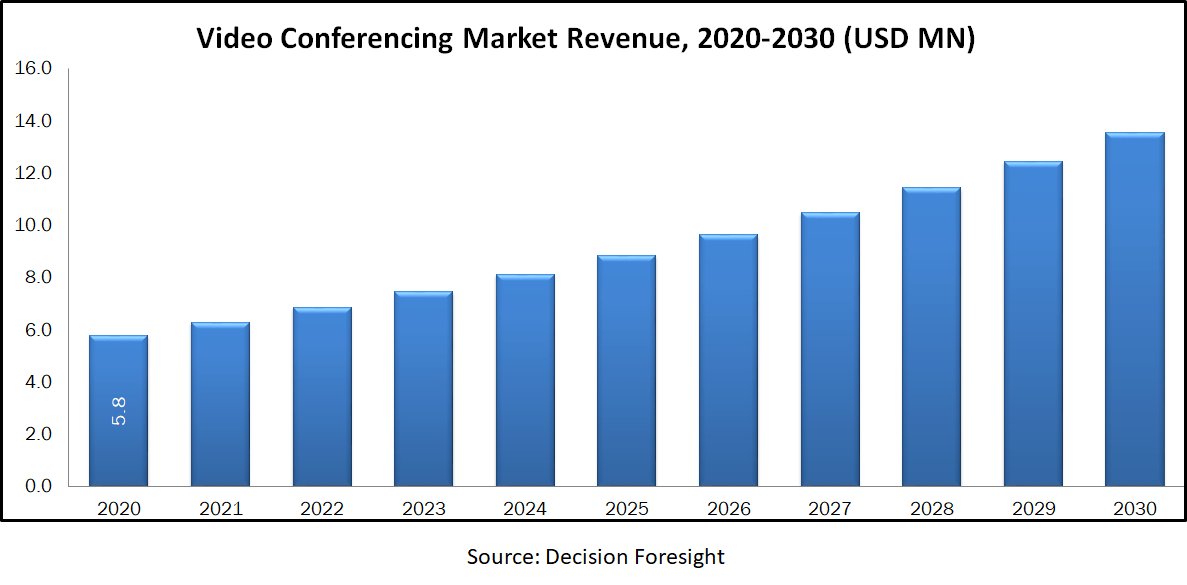Video Conferencing market size was valued at USD 5.78 billion by 2020, growing with 8.9% CAGR during the forecast period, 2021-2030.
Video conferencing - sometimes called video conferencing, web conferencing or more simply "vision" - are computer tools that allow live connections to be established, between two or more distant parties, via the internet, with video, to simulate face to face meetings.Businesses may get significant financial benefits from Video conferencing. Not only may direct savings be made on travel expenses, but also on communication costs. Video conferencing lowers the typically time-consuming organizational work involved in vacation preparation. There is also no downtime, which is not always spent constructively while travelling. Video conferencing save coordination time and enhance staff productivity in organizations with many locations. Short decision-making routes improve responsiveness. CO2 emissions are decreased since certain business travels are unnecessary. In the long term, web conferencing decreases the amount of space needed, which reduces land consumption. Both are environmentally friendly and may be efficiently marketed. The global spread of the Coronavirus has resulted in an unprecedented demand for video conferencing solutions. This technology, which has virtually become a necessary instrument to substitute actual encounters during this period of confinement, has resulted in the birth of a sector that is frequently viewed as unclear yet in full change.
Market Dynamics and Factors:
Microsoft said that its Teams collaboration platform had 44 million daily active users in March, up from 25 million in November. Zoom, the most recent entrant, set a volume record of 300 million participants per day in April 2020. App Annie, a statistics platform in the mobile apps industry, observed 62 million installations between March 14 and 21, a 90 percent increase over the same time in 2019. Zoom completed its February-April quarter with 497,000 clients who employed at least 10 people and subscribed to the premium version of the service, according to one important metric. That was a rise of 29,900 customers in that sector from the November-January quarter, Zoom's weakest three-month growth since before the pandemic began.Zoom, on the other hand, acquired more than 183,000 clients with 10 or more workers over the same period last year, when the pandemic prohibitions were still in their early stages. Those bigger customers will be critical to Zoom's long-term success since they generally commit to longer-term contracts than companies with only a few employees that prefer monetisation.
In June 2021 at Apple's annual Worldwide Developers Conference for software developers apple announced that it has changed several of its applications and services in ways that might aggravate rivalry with Zoom Video Communications Inc and Microsoft Corp's Teams, both of which rose to prominence during the epidemic .It upgraded its FaceTime video chat programme to enable for the scheduling of conversations with multiple participants and to make it compatible with Android and Windows devices.
Market Segmentation:
Video Conferencing Market can be segmented on the basis of by product/service type (Camera, Microphone, Interactive Screens, Headphone, Other Hardware, Software, Service, Professional Services, Managed Services), By User (Corporate, MOOC, IT & Communication, Healthcare, Government & Defence, BFSI, and others) By Deployment (On Premise, and Cloud), By Market Region (North America, Europe, Asia Pacific, Latin America, Middle East and Africa).
Geographic Analysis:
In 2020, North America dominated the video conferencing industry, with a revenue share of more than 39%. In terms of video conferencing solution usage, the regional market is mature. However, there is room for expansion in the region for upgrading existing technology and subscribing to cloud-based services. Increasing internet penetration and surge in number visual meetings is projected to contribute to regional growth. The existence of many important companies, together with the rising popularity of Personal Devices options, which has resulted in widespread use of webcams and headphones, is likely to push market expansion even further.
Competitive Scenario:
The video conferencing market share, which is highly competitive, consists of a few major players. In The key players of Video Conferencing market are Vidyo Inc. (United States), Zoom Video Communication Inc. (United States), Logitech International S.A. (Switzerland), Panasonic Corporation (Japan), Microsoft Corporation (United States), ZTE Corporation (China), Fuze Inc. (United States), Huawei Technologies Co. Ltd. (China), Avaya Inc. (United States), Google, LLC (United States), Facebook, Inc. (United States), Lifesize Inc. (United States), StarLeaf (United Kingdom), Premiere Global Services, Inc. (United States), ezTalks Technology Co., Ltd. (Hong Kong), Bharti Airtel Limited (India),, Cisco (United States), Reliance JioInfocom Limited (India) and others.
Video Conferencing Market Report Scope
| Report Attribute | Details |
| Analysis Period | 2020–2030 |
| Base Year | 2021 |
| Forecast Period | 2022–2030 |
| Market Size Estimation | Billion (USD) |
| Growth Rate (CAGR%) | 8.9 % |
|
| By Product/Service type (Camera, Microphone, Interactive Screens, Headphone, Other Hardware, Software, Service, Professional Services, Managed Services), By User (Corporate, IT & Communication, Healthcare, Government & Defence, BFSI, ) By Deployment (On Premise, Cloud ) |
| Geographical Segmentation | North America (U.S., Canada, Mexico) Europe (UK, Germany, Italy, France, Rest of Europe), Asia-Pacific (China, Japan, India, Australia, Rest of APAC), South America (Brazil, Argentina, Rest of SA), MEA (UAE, Saudi Arabia, South Africa) |
| Key Companies Profiled | Vidyo Inc. (United States), Zoom Video Communication Inc. (United States), Logitech International S.A. (Switzerland), Panasonic Corporation (Japan), Microsoft Corporation (United States), ZTE Corporation (China), Fuze Inc. (United States), Huawei Technologies Co. Ltd. (China), Avaya Inc. (United States), Google, LLC (United States), Facebook, Inc. (United States), Lifesize Inc. (United States), StarLeaf (United Kingdom), Premiere Global Services, Inc. (United States), ezTalks Technology Co., Ltd. (Hong Kong), Bharti Airtel Limited (India),, Cisco (United States), Reliance JioInfocom Limited (India) and others. |







